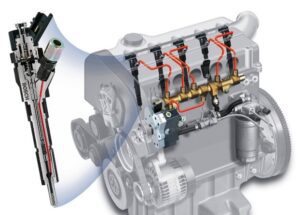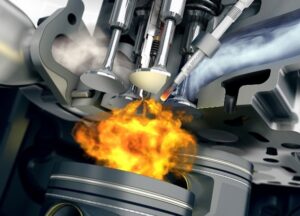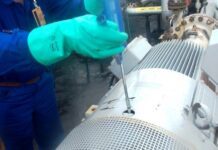
Marcos Thadeu Lobo
Mechanical Engineer Graduated from the State University of Campinas (Unicamp). He currently works as an Associate Consultant at QU4TTUOR CONSULTORIA
Injection System
1.3 – FUEL INJECTION PROCESS
The performance of Ciclo Diesel 4T internal combustion engines is greatly influenced by the design of the fuel injection system. In fact, the most notable advances achieved in the Diesel 4T Cycle internal combustion engines were a direct result of the great technical advances achieved by fuel injection systems. While the main function of the fuel injection system is to dispense fuel to the cylinders of the 4T Cycle Diesel internal combustion engines, the way in which fuel is dispensed makes a huge difference in performance, pollutant emissions and operating noise characteristics.
Images 1/2 – Fuel Injection System: Big Advances
Unlike the fuel injection and spark ignition systems found in the Ciclo Otto 4T internal combustion engines, the fuel injection systems in the Ciclo Diesel 4T internal combustion engines dispense fuel into the cylinders at extremely high pressures.

 Images 3/4 – Thermal stress and very small dynamic clearances
Images 3/4 – Thermal stress and very small dynamic clearances
This particularity demands that the designs and materials of the injection system components be selected in order to withstand the greatest thermal stresses in order to satisfy the service life and performance targets of the internal combustion engines, Ciclo Diesel 4T. Extreme manufacturing precision, very tight dynamic tolerances are required to obtain the maximum efficiency of modern injection systems in Diesel Cycle 4T internal combustion engines, which demands the use of more complex manufacturing controls, more expensive materials, and manufacturing costs higher. These demands account for up to 30% of the cost of the Ciclo Diesel 4T internal combustion engine.

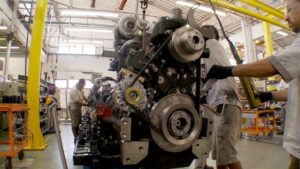 Images 5/6 – Injection system: up to 30% of the cost of the 4T Diesel Cycle engine
Images 5/6 – Injection system: up to 30% of the cost of the 4T Diesel Cycle engine
1.4 – COMBUSTION PROCESS
In Diesel Cycle 4T internal combustion engines, fuel is injected into the cylinders at the end of the Compression engine time. During the period known as “ignition delay”, the fuel spray is nebulized into tiny droplets that vaporize and mix with the air.
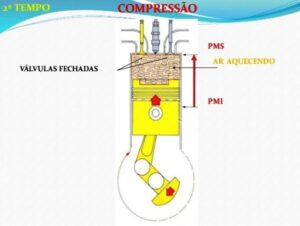
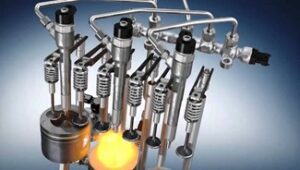 Images 7/8 – Internal Combustion Engine 4T Diesel Cycle: Injected fuel is nebulized in the cylinder near the end of the Compression engine time
Images 7/8 – Internal Combustion Engine 4T Diesel Cycle: Injected fuel is nebulized in the cylinder near the end of the Compression engine time
As the piston continues to move towards the TDC (Upper Dead Point) the temperature of the air-fuel mixture reaches the Ignition Point of the fuel, which causes the instantaneous ignition of part of the pre-mixed volume of air and fuel. The fuel that did not participate in combustion in the air-fuel premix will be consumed in the combustion phase at a controlled rate, also known as combustion diffusion.
 Image 9 – Internal Combustion Engine Cycles 4T Diesel Cycle
Image 9 – Internal Combustion Engine Cycles 4T Diesel Cycle
The interface between the fuel injection system and the combustion process takes place in the form of nebulized fuel. It can be said that the extreme sophistication of the fuel injection system control is mainly due to the need to carry out an adequate nebulization of the fuel in the combustion chamber.

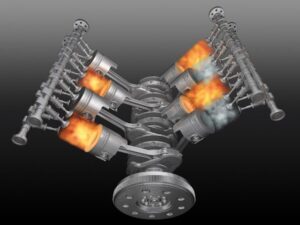 Images 10/11 – Fuel nebulization by the injection unit
Images 10/11 – Fuel nebulization by the injection unit
Fuel nebulization is carried out with the aid of a pressure differential through the injection unit orifices. The fuel is finely divided into droplets of different concentrations and dimensions in the spray formed. The combustion process in the compression ignition system depends, to a large extent, on adequate nebulization of the fuel at the start of ignition, even before the fuel spray has completely formed.
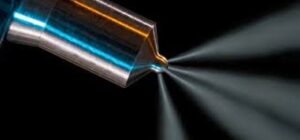
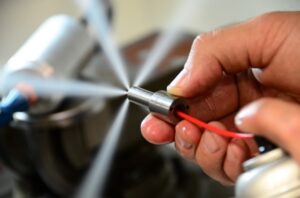 Images 12/13 – The fuel is transformed into a spray by pressure differential in the injection unit, being composed of droplets of different dimensions
Images 12/13 – The fuel is transformed into a spray by pressure differential in the injection unit, being composed of droplets of different dimensions
The spray behavior is of fundamental importance for the proper homogenization of the air-fuel mixture and the start of ignition. Additionally, we can mention that the behavior of the fuel spray in the combustion chamber after the end of the injection is extremely critical in the matter of the formation of pollutant emissions.
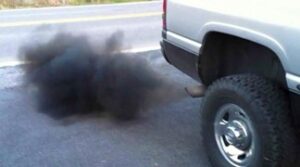
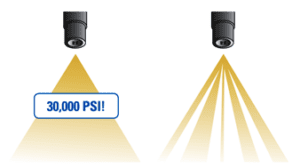 Images 14/15 – The behavior of the fuel spray influences the formation of pollutant emissions
Images 14/15 – The behavior of the fuel spray influences the formation of pollutant emissions




